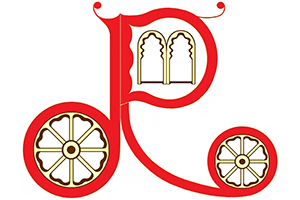历史悠久的城市, 有皇宫, 风景如画的运河和美丽的公园; 圣彼得堡, 俄罗斯

俄罗斯, 圣彼得堡, 凯瑟琳宫殿&公园
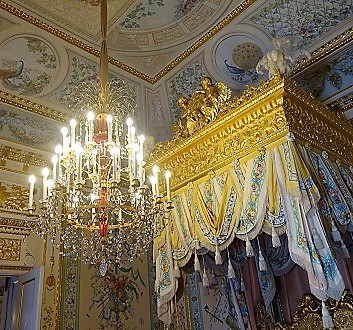
俄罗斯, 圣彼得堡, 巴甫洛夫斯克宫殿&公园
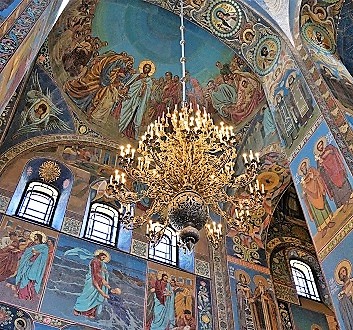
俄罗斯, 圣彼得堡, 教会
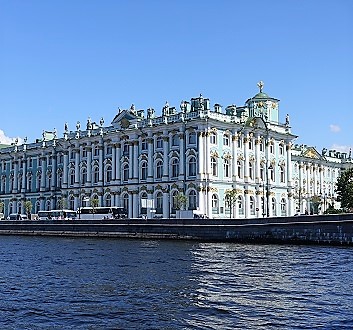
俄罗斯, 圣彼得堡, 国家冬宫博物馆
旅游计划
天 1 - 到达 圣彼得堡, 马林斯基剧院
There are direct flights to/from Saint Petersburg, Russia from European hubs, such as Amsterdam, Paris, Frankfurt and London. We arrive to Saint Petersburg on the SAPSAN Bullet Train from Moscow. Upon our arrival at the Saint Petersburg Railway Station, we utilize the limousine transfer services provided by our hotel. An afternoon arrival offers time for an early dinner and an evening ballet performance of “Don Quichotte” at the beautiful Mariinsky Theatre.
Note: In Saint Petersburg, we used the private travel services offered by TJ Travel (st-petersburg-tours.ru). The influx of tourists during the summer season, requires advanced ticket reservations for many historic sites, including the famous Hermitage Museum. TJ Travel (a tour guide and a driver) planned in advance and managed exceedingly well our desired itinerary. Visitors to Russia from many countries require a visa. At our request, the Kempinski Hotel Moika 22 provided us with documents necessary to apply for a visa at the Russian consulate/embassy in our home country.
天 2 - 凯瑟琳宫殿 & 公园, 巴甫洛夫斯克宫殿 & 公园
Today, we tour the imperial palaces on the outskirts of Saint Petersburg. We drive an hour to the Tsarskoye Selo to explore the Catherine Palace & Park, Russia’s imperial summer palace. The palace has a light blue façade, white columns and five gold domes in the Palace Chapel. Inside the palace, the Great Staircase and the Golden Enfilade (visitor route) guide us through an impressive ensemble of state rooms. We visit the Great Hall that was used for receptions, ceremonies, balls and masquerades. We admire the Amber Room displaying amber panels on the walls, and the Picture Hall designed as a tapestry made of art canvases. A walk through the Catherine Park reveals manicured French style gardens and an English park with strolling pathways, stylish pavilions, tiered terraces, classical statues and picturesque ponds. After departing the Catherine Palace, we pause for lunch and drive a few kilometers to the Pavlovsk Palace and Park, a country residence of the Russian Imperial family. We walk through the English Style Gardens and visit the palace’s interiors, decorated with lavish draperies, colorful porcelain, striking chandeliers and lavish furniture. At the end of the day, we drive back to Saint Petersburg and have dinner nearby out hotel at the Hamlet+Jacks Restaurant (hamletandjacks.com), serving unique modern Russian cuisine.
天 3 - 国家冬宫博物馆, 内河游船, 彼得和保罗要塞
A morning 5 minutes’ walk takes us to the Palace Square and the State Hermitage Museum, a former residence of the Russian tsars. A palace entryway at the Palace Embankment overlooks the Neva River and the Peter and Paul Fortress. Our multi-hour private tour takes us to the Winter Palace, Small Hermitage, New Hermitage, Great (Old) Hermitage, Winter Palace of Peter I and the Hermitage Theater. Inside the Winter Palace, the Jordan Staircase showcases white marble, granite columns and ceiling painting. The Pavilion Hall shows the colonnade of white marble, gilded arcade and the 18th century Peacock Clock. We visit the ceremonial halls, throne room, lavish chambers and the Hermitage Theatre, one of the oldest theatres in Russia. The next stop is in front of our hotel, where we take a leisurely one hour river cruise. After a short lunch, we drive few kilometers by the Neva River, stop at the Spit of Vasilievsky Island landmark and visit the Peter and Paul Fortress. Inside the fortress complex, St. Peter and Paul Cathedral’s interiors are designed with iconostasis, marble columns, stained glass windows, ceiling mosaics and chandeliers. Along the Fortress Walls, we admire the scenery of the Neva River. We drive back to our hotel and then walk 20 minutes to the historic Tsar Restaurant for dinner.
天 4 - 夏宫宫殿 & 公园 , 尤苏波夫宫
Today, we drive an hour to the southern coast of the Gulf of Finland, to visit the Peterhof Palace and Park, the imperial countryside estate. The Peterhof Grand Palace has beautiful Ceremonial Staircase, magnificent gilded Ballroom, colorful Throne Room and series of lavish chambers. Encircling the palace are masterly landscaped gardens and expansive park. In the front of the Grand Palace, the Grand Cascade is a sublime gilded ensemble of statues, fountains and the central statue of Samson wrestling the jaws of a lion. We walk to the shore of the Gulf of Finland to visit a summer palace called Monplaisir, Peter the Great’s retreat. This beautiful countryside estate merits sufficient time to explore its beautiful design. We continue our tour with a short lunch, followed by an hour drive to Saint Petersburg to visit the Yusupov Palace. The Yusupov Palace is a historic residence that belonged to the aristocratic Yusupov family and was the location of Grigori Rasputin’s assassination. The stunning marble Grand Staircase invites visitors to explore the luxurious private chambers, impressive halls and intimate Palace Theater. We drive back a few kilometers to our hotel and then walk to the nearby Rustaveli Restaurant serving an excellent Georgian cuisine.
天 5 - 耶稣基督复活教堂, 俄罗斯国家博物馆
Our tour begins with a 10 minutes’ walk from our hotel to the Church of Resurrection of Jesus Christ, constructed in 1907 in the location where the Russian Tsar Alexander II was wounded in a 1881 terrorist attack. This historic Russian Orthodox Church displays multi-colored onion domes and interiors decorated with beautiful mosaics. We learn about Russia’s tumultuous history through its vivid paintings and religious symbols. A walk to the nearby Mikhailovsky Garden reveals lovely French style garden and an English park. We walk few minutes to the State Russian Museum, an impressive repository of over 400,000 pieces of Russian art. We spend countless hours viewing an incredible collection of art from the 11th to 20th centuries. We discover the beautiful interiors of the Mikhailovsky Palace, designed by the Italian architect Carlo Rossi. We walk through the stunning Vestibule, the White Column Hall and the harmoniously interconnected chambers and halls. At the museum’s café, we enjoy refreshments and a dessert. After the visit, we walk 10 minutes to the Baku Restaurant to sample the Azerbaijan cuisine.
天 6 - 城市游: 大教堂, 桥梁, 历史建筑
Today, we explore Saint Petersburg’s historic center with its magnificent cathedrals, picturesque bridges and beautiful architecture. We drive 10 minutes to tour St. Isaac’s Cathedral, Russian Orthodox Church designed by the French architect Auguste de Montferrand. The cathedral’s façade is decorated with red granite columns and a gilded dome. The Cathedral’s interior is adorned with murals, mosaics and stained glass window inside the altar. Next, we drive by Saint Petersburg’s rivers, channels and bridges, including the oldest one, the Anichkov Bridge. We walk along the historic Nevsky Prospect, the multi-kilometer main street in Saint Petersburg. A visit to the Elisseeff Emporium, a historic building with a famous food hall, give us time to sample local snacks and desserts. We walk 10 minutes along Nevsky Prospect to the Kazan Cathedral, a historic church dedicated to the Russian victory of 1812. The nearby Great Gostiny Dvor is a magnificent shopping arcade with over 100 shops. We spend several hours shopping and appreciating the historic architecture. After dinner, we walk 15 minutes back to our hotel.
天 7 - 普希金博物馆及纪念公寓,夏夏天花园; 米哈伊洛夫斯基剧院
A day of culture starts at the National Pushkin Museum, situated a short distance from our hotel. The museum houses a collection of artifacts and paintings dedicated to the Russian poet Alexander Pushkin. After lunch, we walk 20 minutes to the beautiful Summer Garden, situated between the Moyka River and the Fontanka River. We spend few hours relaxing and walking along the pretty pathways lined with the marble statues. We return to our hotel and have an early dinner at the Bellevue Brasserie. In the evening, we walk 15 minutes to the historic Mikhailovsky Theatre to see the ballet “Romeo and Juliet”, performed inside a spectacular auditorium. After the performance, we walk along the streets of this romantic city and appreciate the lights and warmth of the “White Nights”.
天 8 - 圣彼德堡离开
After breakfast, we transfer to the Pulkovo Airport (approximately 30 minutes) and take our flight home.
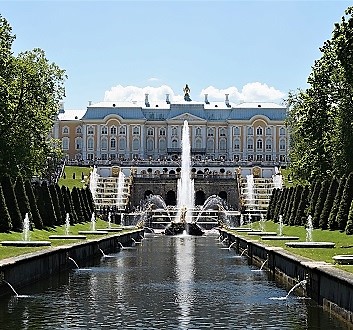
俄罗斯, 圣彼得堡, 夏宫宫殿和公园
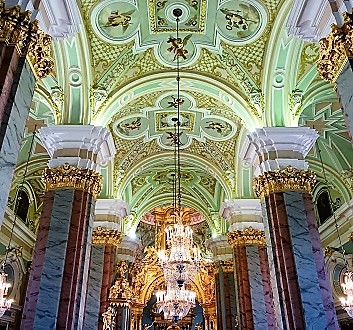
俄罗斯, 圣彼得堡, 彼得和保罗要塞, 圣彼得和保罗大教堂
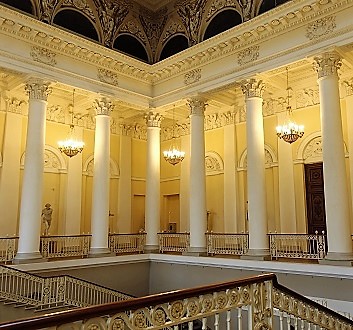
俄罗斯, 圣彼得堡, 博物馆
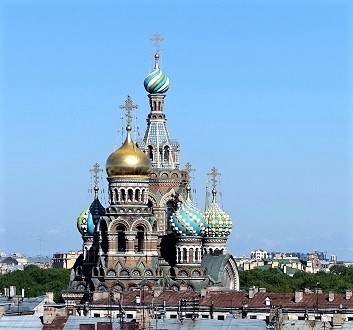
俄罗斯, 圣彼得堡, 教会
特别的地方
圣彼得堡 – The Neva River and the Gulf of Finland beautify the landscape of Saint Petersburg. Saint Petersburg was founded in 1703 by Peter the Great and served as the imperial capital of Russia from 1713 to 1918. The city was built on many islands along the Neva River; hence Saint Petersburg’s landscape is defined by many rivers, channels and bridges. The Fontanka River flows through central Saint Petersburg, along a magnificent architecture, beautiful palaces and picturesque bridges, including its oldest, the Anichkov Bridge. Nevsky Prospect is the main street in the center of Saint Petersburg, originally planned by Peter the Great as the route to Novgorod. The multi-kilometer street houses historic buildings, cathedrals, bridges and store houses. The Elisseeff Emporium, designed in the Art Nouveau style, is a historic building that serves as a department store. The National Library of Russia is the oldest public library in Russia. The Great Gostiny Dvor is a magnificent shopping arcade with over 100 shops. A boat ride or walk along the Moyka River reveals aristocratic mansions and museum, including the National Pushkin Museum. The museum, situated few minutes’ walking from our hotel, is dedicated to the Russian poet Alexander Pushkin. During the summer months, Saint Petersburg experiences the “White Nights” due to its high latitude, resulting in long daylight late in the night. The warm air accompanies us on a romantic walk at night in the city; a city with lively outdoor cafes and historic Hermitage glowing in the evening light. The “White Nights Festival” offers a chance to attend theatre and ballet performances. A visit to Saint Petersburg is not complete without exploring many of its beautiful parks, such as the Summer Garden featuring pretty walkways, fountains and marble sculptures, and the Field of Mars displaying spacious grounds, flower gardens and the eternal flame dedicated to the victims of the Russian Revolution.
国家冬宫博物馆 – State Hermitage Museum is a former residence of the Russian Emperors. It was opened to the public in 1852 and serves as a museum of art and culture. Hermitage is situated between the Palace Embankment and the Palace Square. The Palace Embankment runs along the Neva River and overlooks the Peter and Paul Fortress and Vasilievsky Island. The Palace Square, a central square of Saint Petersburg, displays the Alexander Column in the center, named after the Tsar Alexander I and defined by the statue of an angel with a cross on top. In the square, the General Staff Building is a bow shaped building with two wings and a triumphal arch, dedicated to the victory of the Patriotic War of 1812. Founded by Catherine the Great in 1764, the Hermitage is a symbol of Russia’s imperial history, inspiring culture and Russian Baroque style. The Hermitage Museum consists of the Winter Palace, Small Hermitage, New Hermitage, Great (Old) Hermitage, Winter Palace of Peter I and Hermitage Theater, with all these structures being open to the public. The Winter Palace, the official residence of the Russian Tsars from 1732 until the Russian Revolution of 1917, was rebuilt many times. The preserved Winter Palace was designed by the architect Francesco Bartolomeo Rastrelli in a Russian Baroque style and emphasizes sophistication and luxury. The quadrangle structure displays a magnificent green façade beautified with a white two-tier colonnade, ornamented windows and a roof with statuary. Inside the Winter Palace, the Jordan Staircase is defined by its white marble, granite columns and painting on the ceiling. The décor of the Armorial Hall reveals gilded columns and spectacular chandeliers. The St. George Hall was redesigned in a classical style and was used for state ceremonies. The Memorial Hall of Peter the Great (Small Throne Room) displays the throne with walls decorated in red velvet. The pavilions of the Small Hermitage serve as a connection between the Winter Palace and the Great Hermitage and the New Hermitage. The Pavilion Hall, part of the Small Hermitage, illustrates sublime white interiors, a colonnade of white marble, gilded arcade, spectacular chandeliers, floor mosaics and the 18th century Peacock Clock. Emperor Nicholas I ordered the construction of the New Hermitage to display the art collection. The extensive collection of paintings and sculptures is displayed in lavish chambers, such as the Italian Skylight Room and the Tent-Roofed Room. Next to the Small Hermitage, Empress Catherine the Great entrusted the architect Yuri Velten to construct the Great Hermitage to house a library and a vast art collection. The Hermitage Theatre, built on the former site of Winter Palace of Peter I, is one of the oldest theatres in Russia that historically presented opera performances, masquerade balls, ballet spectacles and opened in 1991 to the public. The Hermitage Museum displays Russia’s grandeur and wealth, the cultural contributions of Catherine the Great, historic ceremonial halls, and an impressive Russian and International art repository. In the basement of the Hermitage Museum live over 50 Hermitage Cats. In the 18th century, the Empress Elizabeth ordered for cats to be brought to the Hermitage to eradicate the mice. Since then, the Hermitage Cats enjoy a pampered life with quality food, veterinary care and designated caretakers taking care of all their needs.
凯瑟琳宫殿 & 公园 – Situated in Tsarskoye Selo, a town in the south of Saint Petersburg, the Catherine Palace and Park is a symbol of Russia’s imperial heritage. The development period of Saint Petersburg led to the construction of the Great Palace of Tsarskoye Selo (Catherine Palace) during the reign of Empress Catherine I. In 1752, Catherine’s daughter Empress Elizabeth entrusted an Italian architect Francesco Bartolomeo Rastrelli to design a summer palace. The Catherine Palace is an extraordinary structure with a light blue façade, white columns decorated with gold ornaments and five gold domes in the Palace Chapel. The palace, designed in the Russian Baroque style, emphasizes a luxurious décor and the utilization of beautiful colors. The Great Staircase displays white interior with a carved balustrade and multi-layered windows, with upper windows covered by the red drapes. The Golden Enfilade (visitor route) guides the visitors through an impressive ensemble of state rooms. The palatial Great Hall is designed with large windows, ceiling painting, and gilded mirrors and walls. The luxurious interior of the Great Hall impresses with its ornamental carvings, and served as a beautiful venue for receptions, ceremonies, balls and masquerades. The Antechambers, decorated with gilded carvings and painted canvases on the ceilings, served as waiting rooms for audiences with the Empress. During the palace reconstruction, two antechambers were converted into the Arabesque Hall and Lyons Hall. A walk through the palace’s chambers astonishes with its lavishly decorated interiors, parquet floors and beautiful chandeliers. The Amber Room is a unique treasure with amber panels displaying mosaic patterns on the walls. The restored Amber Room has some original amber pieces that were given by Frederick of Prussia to the Russian Emperor Peter the Great. The Picture Hall resembles a tapestry created by the aligned collection of art canvases. Adjacent to the Catherine Palace, the Cameron Gallery has distinct white columns on the upper level and provides lovely views of the surrounding park. Empress Catherine the Great (Catherine II) desired a classical colonnade for walking, hence Cameron Gallery was designed by a Scottish architect Charles Cameron. A walk through the Catherine Park reveals manicured French style gardens and an English park with walking avenues, stylish pavilions, tiered terraces, classical statues and picturesque ponds. The Catherine Palace and Park is a historic masterpiece created by world class architects and artists. Tsarskoye Selo, with the nearby Imperial Lyceum, became a summer vacation and education center for the Russian Nobility. The Catherine Palace endured major destruction during the Great Patriotic War, became a museum in 1918 and was beautifully restored to its original grandeur.
巴甫洛夫斯克宫殿 & 公园 – In 1777, Catherine the Great gave her son the Grand Duke Paul and his German-born wife Maria Feodorovna a vast piece of land. This naturally landscaped property is within a few kilometers from Tsarskoye Selo and serves as the beautiful setting for the Pavlovsk Palace and Park. The Pavlovsk Palace and Park, a Country Residence of Russian Imperial family, was designed by an architect Charles Cameron, and later redesigned by Vincenzo Brenna. In 1917, the Pavlovsk Palace and Park became a cultural museum with a large art collection. Forested landscape, English Style Gardens and the Slavyanka River surround the imperial palace, decorative pavilions and lovely bridges, such the Visconti Bridge. The Pavlovsk Palace has a pretty yellow façade with white columns and ornaments. Inside the palace, the stylish interiors are decorated with lavish draperies, colorful porcelain, striking chandeliers and stylish furniture. The palace’s classic style and exquisite craftsmanship are visible in its beautiful chambers. The Italian Hall is a replica of a Roman Temple decorated with a pink and white colored dome and a beautiful chandelier with a bronze frame. The Grand Hall or Throne Room with arched French windows, was used for court ceremonies. The décor of the State Bedroom emphasizes a gilded bed underneath a spectacular canopy with colorful silk draperies. Stepping into the Tapestry Room reveals walls decorated with stunning tapestries produced by Gobelins (tapestry factory in Paris). The contrasting décor is visible at the Hall of War designed with military themes, while the Hall of Peace displays nature and art themes. The stylishly decorated chambers of the Pavlovsk Palace perfectly combine the classic style with the charm of the countryside.
彼得和保罗要塞 – In 1703, Peter the Great founded the Peter and Paul Fortress on the small Hare Island (Zayachy Ostrov) in the Neva River. The Peter and Paul Fortress is accessible by two bridges: the Ioannovsky Bridge and the Kronverksky Bridge. The citadel, a landmark of Saint Petersburg, was a tsarist political prison and serves today as a museum. The Trubetskoy Bastion, constructed in 1872, held many prominent figures during the imperial rule and after the 1917 revolution. Situated inside the fortress complex, St. Peter and Paul Cathedral is the oldest landmark in the city, identified by its gold painted 123 meters spire with an angel atop. The St. Peter and Paul Cathedral, a Russian Orthodox Church, was designed by Domenico Trezzini and built between the years 1712-1733. The cathedral’s interiors are decorated with iconostasis dedicated to Saint Peter and Paul, marble columns, stained glass windows, ceiling mosaics and beautiful chandeliers. The cathedral houses the imperial tombs of the Russian emperors, including the Romanov imperial family. Nearby the cathedral, the Saint Petersburg Mint was constructed in a Neo-Classical style and continues to manufacture coins. A walk along the Fortress Walls reveals small sandy beaches popular during the summer, providing lovely views of the Neva River and the Hermitage Palace.
夏宫宫殿 & 公园 – The Peterhof Palace and Park is a Russian masterwork of countryside estate. It is situated 30 kilometers from Saint Petersburg on the southern coast of the Gulf of Finland. The Palace of Versailles in France became an inspiration for the Russian Emperor Peter the Great to create a summer palace on the outskirts of Saint Petersburg. The Peterhof Palace and Park, a UNESCO World Heritage Site, served as the summer residence of the Russian Tsars until the Russian Revolution in 1917. The Peterhof Palace & Park Complex consists of beautiful palaces, pavilions, expansive gardens and impressive fountains. The Peterhof Grand Palace was originally designed by Jean Baptiste Le Blond and built in 1721. During the reign of the Empress Elizabeth, an Italian architect Bartolomeo Rastrelli preserved the original building, and designed an elegant palace in the center and white pavilions with gilded cupolas on the sides. The palace was heavily damaged during the Second World War but was reconstructed preserving the original designs of Rastrelli and the later additions. The imperial palace’s interior décor is lavish and beautiful with a Ceremonial Staircase, a magnificent gilded Ballroom, a colorful Throne Room and other uniquely decorated imperial chambers. The Peterhof Park and Gardens is elaborate art in nature. The expansive park encompasses masterly landscaped grounds, pavilions decorated with flowers, artistic fountain displays and a picturesque seaside setting. The Peterhof Park and Gardens features an elaborate collection of cascades, fountains and statues. In the front of the Grand Palace, the Grand Cascade is a sublime gilded ensemble of statues, fountains and a central statue of Samson wrestling the jaws of a lion. The Samson Fountain celebrates the Russian victory over the Swedish army in Poltava. The pathway from the Grand Palace to the Marine Canal displays an array of beautifully designed fountains. A walk to the shore of the Gulf of Finland reveals a summer palace called Monplaisir, Peter the Great’s retreat for his family and friends. This modest yet charming palace looks like a grand mansion with large French windows, surrounded by a flower garden and overlooking the sea. In the lower park, the Marly Palace was used by Peter the Great to store his collection of art and treasures received as gifts. This magnificent imperial country estate offers visitors joyful hours visiting the palace, exploring the expansive park, and relaxing by the fountains and the sea.
尤苏波夫宫 – Situated on the Moyka River (Мойка), the Yusupov Palace is a historic residence that belonged for many generations to the aristocratic Yusupov family. The Yusupov Palace is also the place where in 1916, Prince Felix Yusupov conspired with other plotters to assassinate Grigori Rasputin, a close adviser of the Emperor Nicholas II and his wife. Inside the palace, there is a Rasputin display that retells the story of the conspiracy. The palace, currently a museum, has beautifully restored 19th century interiors. The stunning marble Grand Staircase invites visitors to explore the luxurious private chambers of the Yusupov family and the impressive halls, such as Banquet Hall, Antique Hall, and the Palace Theater. The lovely Palace Theater is designed in the Rococo style and serves as a beautiful and intimate venue for music and theater performances. During our visit, a small group of singers performed a wonderful musical repertoire.
俄罗斯国家博物馆 – Russia’s culture and history are vividly captured in the Russian art. The State Russian Museum is an impressive repository of over 400,000 pieces of Russian art from the 11th to the 20th centuries, including Russian Folk Art and private collections of art confiscated after the Russian Revolution. The State Russian Museum complex consists of the Mikhailovsky Palace, Stroganov Palace, Marble Palace, St. Michael’s Castle, Mikhailovsky Garden and the Summer Palace of Peter I. The main museum building is the Mikhailovsky Palace, designed by the Italian architect Carlo Rossi in the Russian Neoclassical style. The four-storey building has a yellow façade with white columns. Inside the building, the Vestibule displays the splendor of Rossi’s design with beautiful stairways, striking colonnade and statues decorating the walls. A walk through the museum reveals a harmonious design seamlessly connecting the private chambers, ceremonial halls and galleries. The magnificent White Column Hall and main staircase are the original preserved interiors. The museum’s extensive art collection educates us about Russia’s fascinating and colorful history.
历史悠久的大教堂 – Saint Petersburg’s history is visibly displayed in its architecture and religious symbols. The cathedrals in Saint Petersburg are masterpieces of talented craftsmen and artists. The St. Isaac’s Cathedral, a Russian Orthodox Church, was designed by the French architect Auguste de Montferrand. The cathedral’s façade is decorated with red granite columns and a gilded dome. The Cathedral’s interior is extraordinarily beautiful and is adorned with murals, mosaics and stained glass window inside the altar. The Church of Resurrection of Jesus Christ, known as Saviour of Church on Spilled Blood, was constructed in 1907 in the place where the Russian Tsar Alexander II was wounded in the 1881 terrorist attack. The church was designed in the Russian style and features multi-colored domes, beautiful mosaics and a shrine displayed on the area where Alexander II was fatally wounded. The Kazan Cathedral was constructed in 1801-1811 and serves today as a museum. The church is dedicated to the Russian victory in 1812 over France and Napoleon. A visit to these cathedrals not only educates about their history, but is a place for a spiritual reflection.
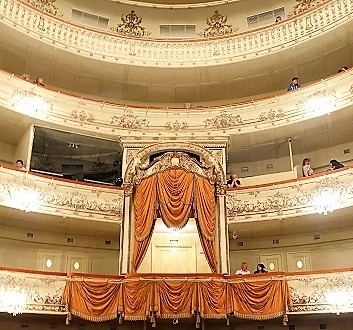
俄罗斯, 圣彼得堡, 米哈伊洛夫斯基剧院
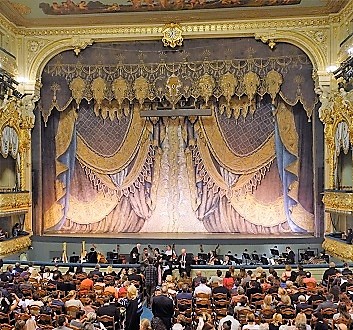
俄罗斯, 圣彼得堡, 马林斯基剧院
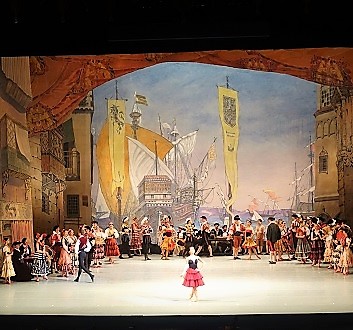
俄罗斯, 圣彼得堡, 马林斯基剧院
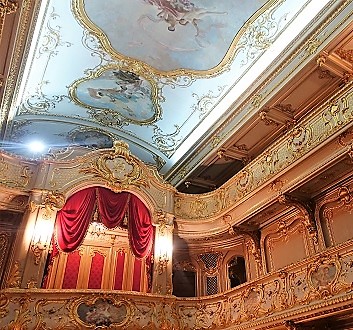
俄罗斯, 圣彼得堡, 尤苏波夫宫, 剧院
最好的冒险
剧院 – The theaters in Saint Petersburg illustrate Russia’s profound dedication to cultivating and preserving its art and culture. Saint Petersburg’s cultural heritage is displayed in its many extraordinary theaters. We visit a few theaters with an incredible architecture and that historically hosted world-class performances. The Mikhailovsky Theatre is a historic Opera and Ballet House founded in 1833 and built by Alexander Brullov. Standing at the Arts Square, we admire the Monument to the Alexander Pushkin and the nearby neoclassical building housing the Mikhailovsky Theatre. Inside the theater, a spectacular auditorium is adorned with orange velvet, a ceiling mural and a beautiful chandelier. The “Romeo and Juliet” ballet is played during our stay, offering us a chance to watch a superb performance in this historic theatre. The Mariinsky Theatre, established in 1783, is one of the oldest theaters in Russia and world-known Opera and Ballet theatre. The current theatre opened 1860 and its name Mariinsky honors its prominent patroness, the Empress Maria Alexandrova. Entering this beautiful theatre, we are impressed with the elegant auditorium and its ceiling mural, eye-catching chandelier, gilded ornaments and spectacular stage. The Mariinsky Theatre held countless premiers of opera and ballet masterpieces performed by the most accomplished artists, dancers and singers. Settled comfortably in this beautiful theatre, we enjoy a dynamic ballet performance of the classic “Don Quixote”.
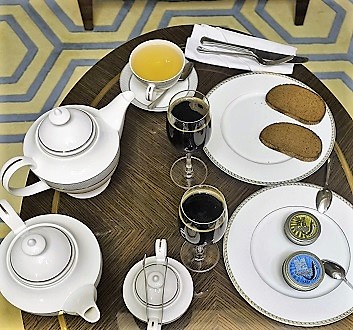
俄罗斯, 圣彼得堡, 鱼子酱
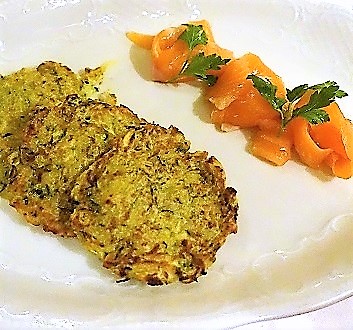
俄罗斯, 圣彼得堡, 薄煎饼
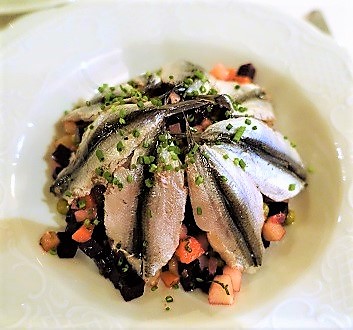
俄罗斯, 圣彼得堡, 沙拉
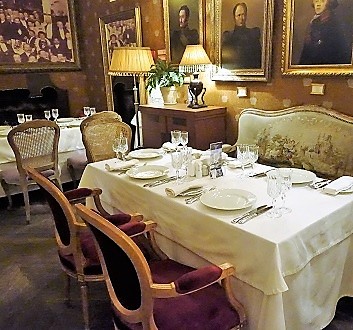
俄罗斯, 圣彼得堡, Tsar 餐厅
所选的菜
鱼子酱 – The waters of the Caspian Sea are the source of the best caviar in the world. Caviar is the salt-cured roe (fish eggs) collected from sturgeon, the anadromous fish. There are 26 species of sturgeon that became endangered due to overfishing and environmental pollution. Caviar is part of the Russian and Iranian cuisines since a long time. In imperial Russia, caviar was a delicacy consumed by the tsars and the Russian nobility, and became a highly prized commodity. Caviar is collected from three types of sturgeon: Beluga, Osetra and Sevruga. The caviar’s price and quality are based on its flavor, texture, color and age of the sturgeon. The Beluga caviar pearls are larger and delicate; Ossetra caviar eggs are firmer with color ranging between brown to golden; Sevruga caviar pearls are smaller and have strong flavor. In Russia, caviar is traditionally served with Russian Pancakes (блины). Our preference is to eat caviar by itself to really appreciate its flavors. We bought Beluga and Ossetra caviar and enjoyed it in two ways: without any additions and with thinly sliced rye bread. The Caviar from the Caspian Sea tastes simply delicious and should be sampled while in Russia.
薄煎饼 (блины) – Blinis (блины), called Russian pancakes, are a delicious staple food in Russian cuisine. The pancakes are traditionally made with wheat or buckwheat flour, yeast, milk and eggs. The thin pancakes, similar to French crepes, are served with varied sweet or savory toppings, such as jams, white cheese, fresh fruits, caviar and smoked salmon. Maslenitsa, an old Slavic holiday, is an elaborate week-long celebration in Russia that marks the end of winter and the beginning of spring. Russian pancakes are the centerpiece of the festivities and are eaten in abundance with inventive toppings. In Saint Petersburg, we taste different types of pancakes made with flour batter mixed with grated vegetables. At the Tsar Restaurant (en.ginza.ru/spb/restaurant/tsar), located in the historic building on the 12 Sadovaya Street, we sample classic Russian and European cuisine, including Zucchini Pancakes served with Atlantic Salmon. A dinner at the Tsar Restaurant enchants us with its beautiful classic décor, sublime cuisine and preserved imperial tradition, such as playing an anthem at 9:00PM that was played during the imperial era.
Vareniki (俄罗斯饺子) – Saint Petersburg’s cuisine is influenced by its imperial history, colder northern location and the western cuisine. Across Eastern Europe, dumplings stuffed with different fillings, are traditional and popular menu item. In Russia, Vareniki are crescent shaped dumplings made from flour, eggs and mixture of water, milk and sour cream. The savory dumplings are traditionally stuffed with cheese, potatoes, mushroom or sauerkraut. The sweet dumplings are filled with different kinds of fruits or white cheese slightly sweetened. The Vareniki with Sour Cherries are simply delicious. These delicate dumplings are equally sweet and sour, and are served with a sublime sour cherry sauce.
民族餐厅 – Russia is an intriguing multi-cultural nation that has an immensely diverse cuisine. Russia is a country made of republics with their own unique culture, ethnicity and cuisine. The collapse of the Soviet Union enabled some republics to declare their independence, yet their unique cuisines continue to be celebrated across Russia. A short walk from our hotel (Kempinski Hotel Moika 22) along the Moyka River takes us to the Rustaveli Restaurant (rustaveli.spb.ru, Moyka Embankment Building 9) that serves an excellent Georgian cuisine. We enjoy delicious kebabs made with minced lamb, baked eggplants, stuffed pie with Saluguni cheese and a fresh vegetable salad. The restaurant also serves refreshing drinks made from fresh herbs and citrus fruits. Another evening, we dine at the Baku Restaurant (restoran-baku.ru), situated within 20 minutes waking distance from out hotel. Baku Restaurant serves a superb Azerbaijan cuisine in an exotically decorated dining room. We order their homemade lemonade made with specialty herbs and lime juice, lamb kebabs with fresh vegetables and traditional Baku sweets.
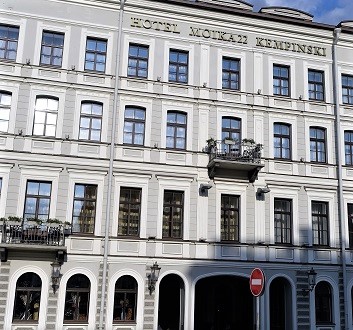
俄罗斯, 圣彼得堡, Kempinski Hotel Moika 22
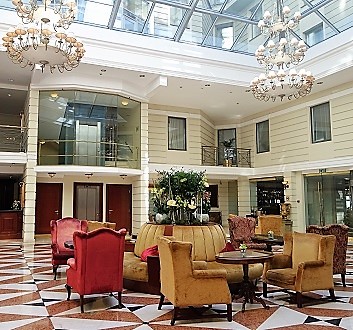
俄罗斯, 圣彼得堡, Kempinski Hotel Moika 22
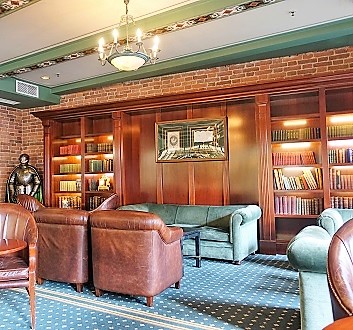
俄罗斯, 圣彼得堡, Kempinski Hotel Moika 22
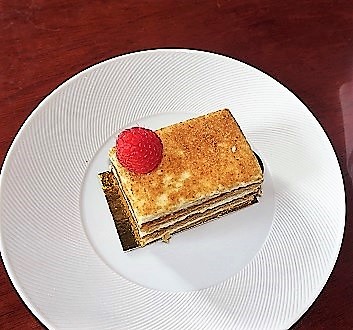
俄罗斯, 圣彼得堡, Kempinski Hotel Moika 22
首选酒店
Kempinski Hotel Moika 22 – The luxurious Kempinski Hotel Moika 22, situated on the Moyka River, faces the historic Palace Square and the Hermitage Museum. The hotel is within a walking distance to Saint Petersburg’s historic street called Nevsky Prospect, museums, theatres and restaurants. The hotel offers collection of suites and rooms with river and city views, stylish décor and spacious lounge area. We recommend a higher floor accommodation overlooking the Moyka River. In the morning, the breakfast buffet offers a selection of cured meats, smoked fish, red caviar, fresh breads, sweet pastries and made to order local specialties. At the top of the hotel, Bellevue Brasserie serves an excellent cuisine while offering panoramic views of Saint Petersburg’s historic sites. The concierge provide quality services, including organizing theatre tickets, restaurant reservations and visa support letter that is needed to apply for the Russian visa in your country. Kempinski Hotel Moika 22 offers a European luxury in the heart of Russia’s cultural capital.
